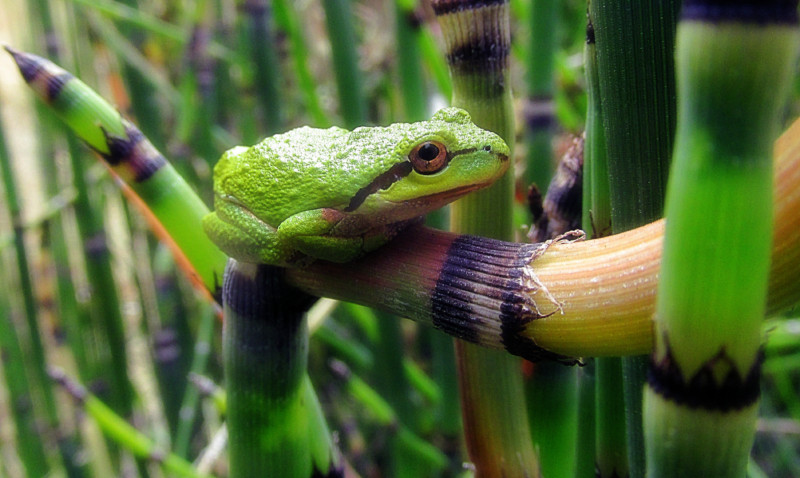
The small but musical Pacific Tree Frog can be found all along the West Coast of the United States, from California to Alaska. Photo by TJ Gehling licensed by CC BY-NC-ND 2.0.
By Eileen Garvin. May 10, 2018. The frogs sang through the wet green morning after Easter. They had started when it was still hard dark, bleating intermittently across the yard as if cajoling the sun not to rise. Sometime after dawn or the hour that should have been dawn, it became clear that this morning would have no sunrise. It would blossom instead from wet pearl grey into a damp, pregnant April day with purple clouds piling up over Mitchell Point. The frogs like the dark and the rain, which are the conditions best for mating season. As for me, I love to listen to their sound, the quintessential song of spring that fills me with an almost physical joy.
Pacific Tree Frogs (Pseudacris Regilla) are sometimes called chorus frogs, so it seems fitting that I’ve always thought of their springtime sound as singing. That signature vocalization is the sound of males attempting to attract females to the water’s edge to mate. As one starts, others nearby join in, competing to interest any available lady frogs in a torrent of overlapping ribbiting. They arrange themselves under rocks and logs to capture the acoustics and make themselves sound louder and bigger, throwing their voices like ventriloquists, like old time dance callers, like little invisible men with omni mics.
I heard the first one in February, a singular croaking query across the frosted grass in my yard: “Anybody awake?” By spring, the frogs are out of hibernation in full force and gathering at the pond in my yard and in the ditches, slack water ponds and seasonal flood plains around the Gorge. From flooded meadows at the Syncline to the oak forests of Mosier, you can hear their hubbub. One year I found a small green specimen yodeling his wee heart out in the echo chamber of my decommissioned hot tub. Their competitive noise making creates a rising cacophony that makes them sound exponentially greater in number than they are. And in size, too. They are tiny, beautiful things.
The Pacific Tree Frog measures no more than two inches long and is among the most common and healthy of Oregon’s twelve native species of frogs and toads. Their color varies from lime green to brown and they can morph in hue to blend into their surroundings. A black stripe stretches from the nose across the eye to the shoulder. Males have a dark patch on the throat marking the vocal sac, which expands when they call. They have long legs, bumpy skin and sticky toe pads, which are useful for hunting. The males have an extra toe pad on their thumbs for mounting females during mating.

Also known as chorus frogs, they usually sing for one of two reasons: to mark their territory or find a mate. Photo by matt knoth licensed by CC BY-NC-ND 2.0.
According to the Oregon Department of Fish and Wildlife (ODFW), the croaking I heard in February—a single and landlocked note from a waking hibernator—happens on high humidity winter days and is likely a territorial call. The typical springtime courting is a two-toned “rib-bit” or “kreck-ek.” I’ve also read about a third sound, a kind of trilling they make when they are in the process of mating. I’ve noticed they aren’t deterred by neighborhood noise and actually seem inspired by it, starting up at the sound of a barking dog, a human voice or someone strumming a guitar. One of the first years we lived here, I sat with friends around the fire pit and we marveled at how they seemed to out shout us. It got so loud that one woman was convinced the frog sound was a recording and we were pulling her leg.
Once enticed to the water’s edge, a female lays up to 750 eggs in separate clumps, which the male fertilizes. Each egg mass is surrounded by a protective jelly and attaches to vegetation, often becoming camouflaged by algae. Eggs hatch in three to five weeks, quickly growing into tadpoles, and within eight to ten weeks, half-inch juveniles climb out of the water to live on land nearby and return for the next breeding season.
As the spring heats up and the rain tapers off, so does the evening concert of the chorus frogs. I check the pond every few days to see if the eggs masses are wiggling or if any tadpoles are feeding on the algae-covered rocks. If I’m lucky, I will see a tiny juvenile hopping about in the shrubs. I don’t try too hard to find them, though. I think it’s better to leave them alone. I just like knowing that some of them have made it out of the water.
ODFW says that most chorus frogs die at egg or tadpole stage. They are eaten by fish, bullfrogs, birds and dragonfly larvae. Skunks, raccoons, garter snakes and owls are among the many predators that feed on young adult frogs. Humans also take their toll in the form of lawn mowers, pesticides, cats and curious children.
Despite the high rates of mortality, the Pacific Tree Frog is a thriving species. They have no conservation status and are celebrated as the State of Washington’s official amphibian. They live in Northern California, Oregon, Washington, British Columbia and southeast Alaska where they presumably find plenty of pond detritus, algae, and pollen to eat as tadpoles and, as adults, spiders, ants, beetles and other insects that are often as large as they are.
Not so with the Oregon Spotted Frog, listed as threatened by the U.S. Fish and Wildlife Service in 2014. The spotted frog is also native, and has a similar breeding season to and period of metamorphosis as the chorus frog. The Oregon Spotted Frog is now extinct from 70 percent of its historic range, including the entire Willamette Valley, according to the USGS Forest and Rangeland Ecosystem Science Center at Oregon State University.
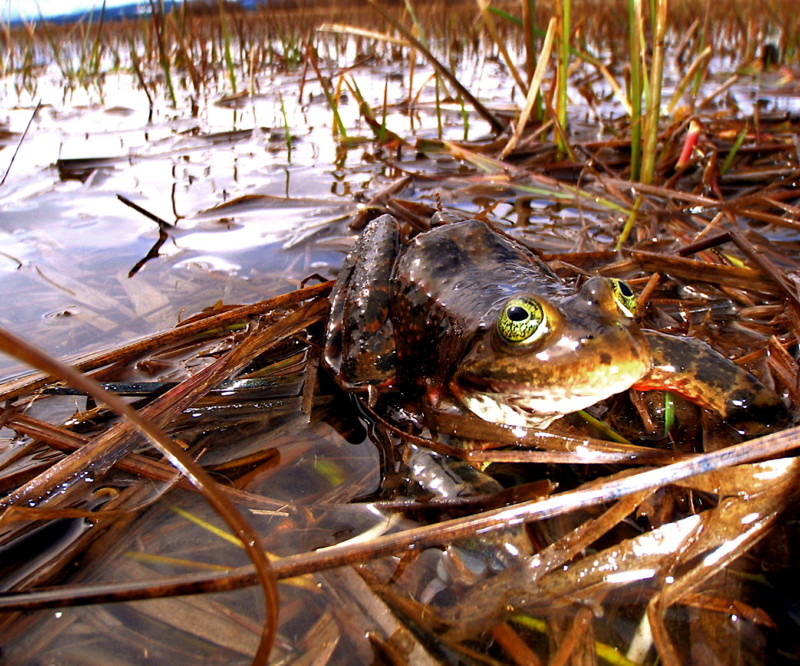
Unlike the prolific Pacific Tree Frogs, the Oregon Spotted Frog is listed as “threatened” and has disappeared from much its historic range. Photo courtesy of USFWS licensed by CC BY-NC 2.0.
The center’s Christopher Pearl said the loss or alteration of wetland habitat is likely the main cause of decline in the Oregon Spotted Frog.
“Other factors like interactions with nonnative species may also play a role but these are harder to assess,” Pearl said.
Regionally, the Oregon Spotted Frog can be found at the Ridgefield National Wildlife Refuge near Vancouver, Washington, and at Conboy Lake National Wildlife Refuge near Trout Lake.
Trevor Sheffels, Conboy Lake refuge manager, said a recently completed annual survey of Oregon Spotted Frog eggs showed the number was down slightly from the previous year but had stabilized from the steep decline seen in recent years. That’s good news for more than just the Oregon Spotted Frog.
“When we talk about ecosystem, everything is interconnected,” he said. “If we lose one part, everything starts to fall out of balance.”
Pearl said that chorus frogs remain in areas from which the spotted frog has disappeared, like the Willamette Valley. He said it’s difficult to determine why the one species continues to thrive when the other does not.
“The fact that chorus frogs can use vernal and temporary pools while OSF typically do not is one likely factor. Another important difference is that chorus frogs leave their ponds by mid-summer and are terrestrial for most of their life history after leaving natal ponds. They are thus less likely to experience stressors associated with aquatic environments,” Pearl said.
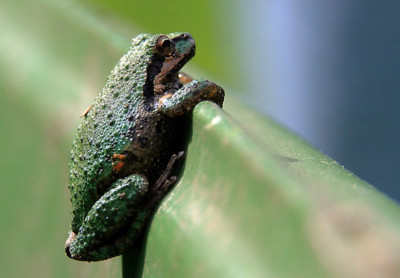
Tree frogs can often be found right in your backyard. Photo by TJ Gehling licensed by CC BY-NC-ND 2.0.
ODFW has a list of suggestion about how to help the chorus frogs and other similar species thrive, and it includes a list of don’ts. Don’t introduce non-native fish, bullfrogs or snapping turtles to ponds and streams. Don’t use pesticides or herbicides in the yard. Don’t let invasive species like canary grass take over. You can also help by being a little messy. Leave a portion of the grass un-mowed and some leaf litter under shrubs. The benefits are mutual, it seems. The chorus frog eats mosquitos, midges and slugs with its long sticky tongue, and contributes to nutrient flows within backyard ecosystems. Pearl pointed out that they are also likely the first wildlife children can appreciate, beginning with their memorable sound.
Not everyone loves the amorous song of the chorus frog. I’ve had visitors tell me they couldn’t sleep and know of residents who moved away because they found the noise so unpleasant. I can’t image that because I have grown to love the sound so much. It’s a metronome for the season. The nighttime concert reminds me that the days are growing longer, the rains are tapering off and the winds are picking up. Springtime, like any season, is fleeting, along with the inhospitable rains. The bite of nighttime frost that sets smudge pots chugging to life in the orchards before dawn will soon disappear. The sun will burn hotter and we’ll make room for the throngs of tourists, friends and relatives who come to share this beautiful place we call home. That’s a different kind of joy, but in the midst of that, I’ll keep an ear tuned to the water’s edge and to see if I can catch the final notes of this season’s receding song.



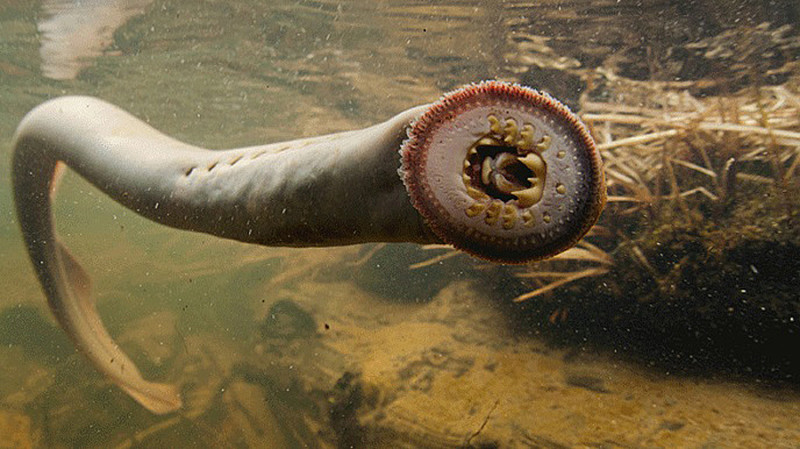


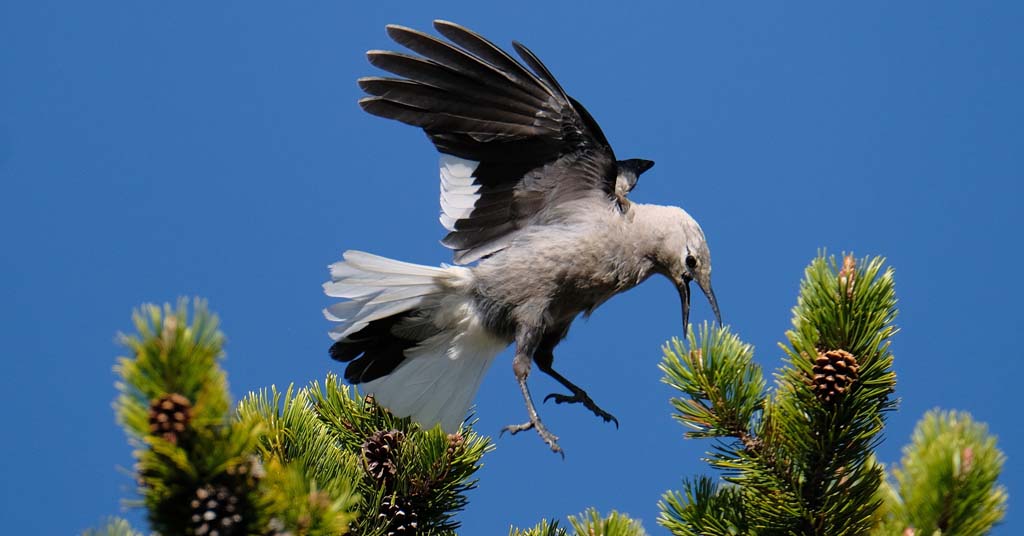
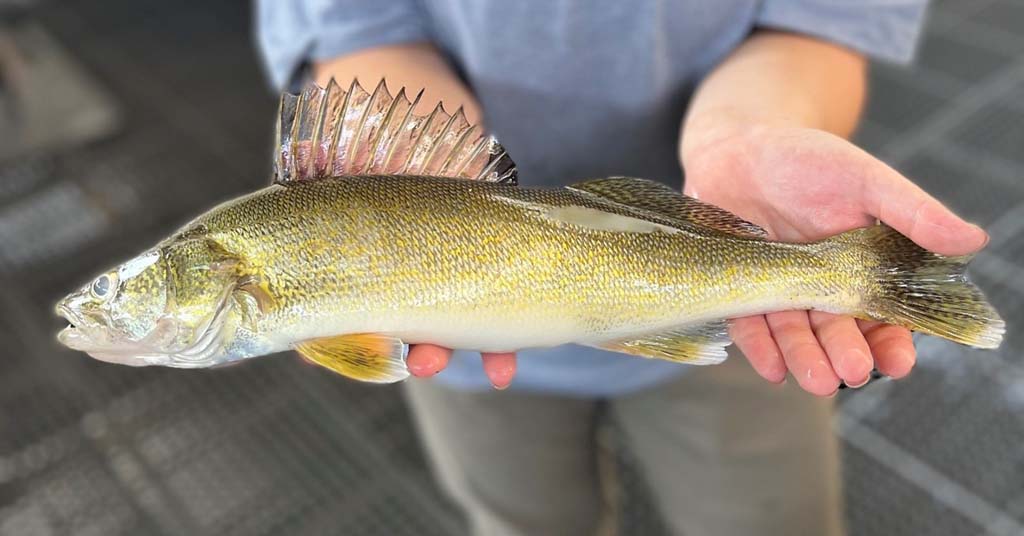



Lovely story greatly appreciated by someone who loves frog concerts!!
Definitely love their chorus at sunset.